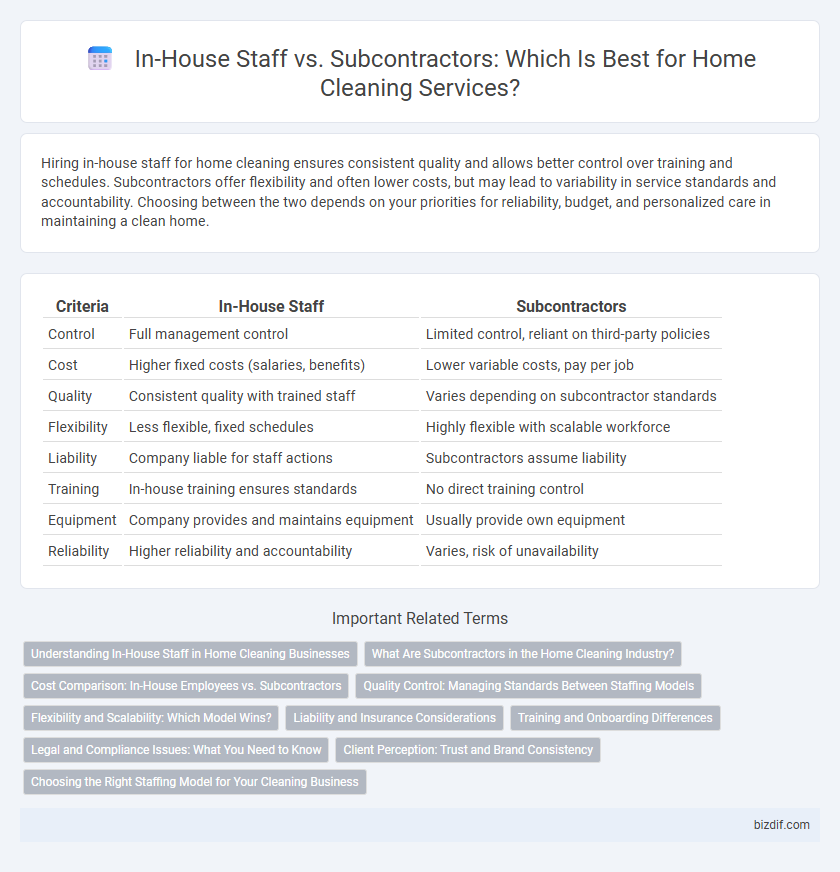Hiring in-house staff for home cleaning ensures consistent quality and allows better control over training and schedules. Subcontractors offer flexibility and often lower costs, but may lead to variability in service standards and accountability. Choosing between the two depends on your priorities for reliability, budget, and personalized care in maintaining a clean home.
Table of Comparison
| Criteria | In-House Staff | Subcontractors |
|---|---|---|
| Control | Full management control | Limited control, reliant on third-party policies |
| Cost | Higher fixed costs (salaries, benefits) | Lower variable costs, pay per job |
| Quality | Consistent quality with trained staff | Varies depending on subcontractor standards |
| Flexibility | Less flexible, fixed schedules | Highly flexible with scalable workforce |
| Liability | Company liable for staff actions | Subcontractors assume liability |
| Training | In-house training ensures standards | No direct training control |
| Equipment | Company provides and maintains equipment | Usually provide own equipment |
| Reliability | Higher reliability and accountability | Varies, risk of unavailability |
Understanding In-House Staff in Home Cleaning Businesses
In-house staff in home cleaning businesses are employees directly hired and managed by the company, allowing for consistent training, quality control, and accountability. This model ensures uniform service standards and fosters stronger employee loyalty, which can lead to improved customer satisfaction. Employing in-house cleaners also provides greater flexibility in scheduling and implementing business policies, enhancing operational efficiency.
What Are Subcontractors in the Home Cleaning Industry?
Subcontractors in the home cleaning industry are third-party professionals or companies hired to perform cleaning services on behalf of a primary cleaning business. These workers operate independently, managing their own schedules, supplies, and insurance, which reduces overhead costs for the hiring company. Utilizing subcontractors offers flexibility and scalability but may result in varying service quality due to less direct oversight.
Cost Comparison: In-House Employees vs. Subcontractors
In-house employees often incur higher fixed costs due to salaries, benefits, insurance, and training expenses, which can significantly increase the overall budget for home cleaning services. Subcontractors provide a variable cost model, charging per assignment without the overhead of employee benefits, allowing for greater financial flexibility. Cost efficiency depends on service frequency and scale, with subcontractors usually more cost-effective for sporadic cleaning needs, while in-house staff suits consistent, high-volume operations.
Quality Control: Managing Standards Between Staffing Models
In-house cleaning staff allows for direct oversight, enabling consistent adherence to company quality standards through regular training and performance evaluations. Subcontractors may vary in service quality due to differing management practices, making standardized quality control challenging across multiple providers. Implementing clear contracts with detailed service level agreements helps maintain consistency regardless of the staffing model.
Flexibility and Scalability: Which Model Wins?
In-house staff provide consistent availability and better control over cleaning quality, ensuring tailored service for fluctuating schedules. Subcontractors offer superior scalability, enabling businesses to easily adjust workforce size during peak or off-peak periods without long-term commitment. For flexibility, subcontractors excel, but in-house teams deliver reliability and closer supervision, making the choice dependent on specific operational priorities.
Liability and Insurance Considerations
Choosing between in-house staff and subcontractors for home cleaning impacts liability and insurance coverage. In-house staff typically fall under the company's workers' compensation and liability policies, reducing direct exposure for homeowners. Subcontractors, however, often carry their own insurance, and verifying their coverage is crucial to avoid gaps in liability protection during cleaning services.
Training and Onboarding Differences
In-house cleaning staff undergo comprehensive training programs tailored to company standards, ensuring consistent quality and compliance with safety protocols. Subcontractors typically receive minimal onboarding, often limited to basic guidelines, which may result in variable service quality and procedures. Investing in in-house training enhances reliability and alignment with brand values, while reliance on subcontractors often compromises thorough skill development and standardized practices.
Legal and Compliance Issues: What You Need to Know
In-house cleaning staff require compliance with labor laws such as minimum wage, overtime, workers' compensation, and tax withholding, ensuring full employer liability and benefit obligations. Subcontractors demand strict contracts to define the scope of work and indemnification clauses, but they shift liability and tax responsibilities away from the hiring company, posing risks if misclassified. Understanding local labor regulations and properly classifying workers prevents fines, lawsuits, and compliance violations in home cleaning operations.
Client Perception: Trust and Brand Consistency
Clients often perceive in-house staff as more trustworthy due to direct company oversight and consistent training, enhancing brand reliability. Subcontractors may introduce variability in service quality, potentially affecting client trust and diminishing brand consistency. Maintaining uniform standards and clear communication bolsters client confidence regardless of staffing models.
Choosing the Right Staffing Model for Your Cleaning Business
Selecting the right staffing model for your cleaning business directly impacts service quality and operational efficiency. Employing in-house staff ensures consistent training, better control over cleaning standards, and fosters loyalty within your team. Conversely, subcontractors offer flexibility and reduced overhead costs but may pose challenges in maintaining uniform service quality and accountability.
In-House Staff vs Subcontractors Infographic

 bizdif.com
bizdif.com